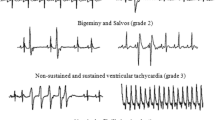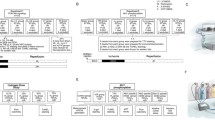Abstract
Purpose
Inhalation of hydrogen (H2) gas has been shown to limit infarct size following ischemia-reperfusion injury in rat hearts. However, H2 gas-induced cardioprotection has not been tested in large animals and the precise cellular mechanism of protection has not been elucidated. We investigated whether opening of mitochondrial ATP-sensitive K+ channels (mKATP) and subsequent inhibition of mitochondrial permeability transition pores (mPTP) mediates the infarct size-limiting effect of H2 gas in canine hearts.
Methods
The left anterior descending coronary artery of beagle dogs was occluded for 90 min followed by reperfusion for 6 h. Either 1.3% H2 or control gas was inhaled from 10 min prior to start of reperfusion until 1 h of reperfusion, in the presence or absence of either 5-hydroxydecanoate (5-HD; a selective mKATP blocker), or atractyloside (Atr; a mPTP opener).
Results
Systemic hemodynamic parameters did not differ among the groups. Nevertheless, H2 gas inhalation reduced infarct size normalized by risk area (20.6 ± 2.8% vs. control gas 44.0 ± 2.0%; p < 0.001), and administration of either 5-HD or Atr abolished the infarct size-limiting effect of H2 gas (42.0 ± 2.2% with 5-HD and 45.1 ± 2.7% with Atr; both p < 0.001 vs. H2 group). Neither Atr nor 5-HD affected infarct size per se. Among all groups, NAD content and the number of apoptotic and 8-OHdG positive cells was not significantly different, indicating that the cardioprotection afforded by H2 was not due to anti-oxidative actions or effects on the NADH dehydrogenase pathway.
Conclusions
Inhalation of H2 gas reduces infarct size in canine hearts via opening of mitochondrial KATP channels followed by inhibition of mPTP. H2 gas may provide an effective adjunct strategy in patients with acute myocardial infarction receiving reperfusion therapy.





Similar content being viewed by others
References
Ovize M, Baxter GF, Di Lisa F, et al. Postconditioning and protection from reperfusion injury: where do we stand? Position paper from the Working Group of Cellular Biology of the Heart of the European Society of Cardiology. Cardiovasc Res. 2010;87:406–23.
Hausenloy DJ, Baxter G, Bell R, et al. Translating novel strategies for cardioprotection: the Hatter Workshop Recommendations. Basic Res Cardiol. 2010;105:677–86.
Kitakaze M, Asakura M, Kim J, et al. Human atrial natriuretic peptide and nicorandil as adjuncts to reperfusion treatment for acute myocardial infarction (J-WIND): two randomised trials. Lancet. 2007;370:1483–93.
Sun Q, Kang Z, Cai J, et al. Hydrogen-rich saline protects myocardium against ischemia/reperfusion injury in rats. Exp Biol Med. 2009;234:1212–9.
Hayashida K, Sano M, Ohsawa I, et al. Inhalation of hydrogen gas reduces infarct size in the rat model of myocardial ischemia–reperfusion injury. Biochem Biophys Res Commun. 2008;373:30–5.
Hausenloy DJ, Ong S-B, Yellon DM. The mitochondrial permeability transition pore as a target for preconditioning and postconditioning. Basic Res Cardiol. 2009;104:189–202.
Di Lisa F, Canton M, Carpi A, et al. Mitochondrial injury and protection in ischemic pre- and postconditioning. Antioxid Redox Signal. 2011;14:881–91.
Heusch G, Boengler K, Schulz R. Inhibition of mitochondrial permeability transition pore opening: the Holy Grail of cardioprotection. Basic Res Cardiol. 2010;105:151–4.
Piot C, Croisille P, Staat P, et al. Effect of cyclosporine on reperfusion injury in acute myocardial infarction. N Engl J Med. 2008;359:473–81.
Ohsawa I, Ishikawa M, Takahashi K, et al. Hydrogen acts as a therapeutic antioxidant by selectively reducing cytotoxic oxygen radicals. Nat Med. 2007;13:688–94.
Kitakaze M, Node K, Minamino T, et al. Role of activation of protein kinase C in the infarct size-limiting effect of ischemic preconditioning through activation of ecto-5′-nucleotidase. Circulation. 1996;93:781–91.
Mori H, Haruyama S, Shinozaki Y, et al. New nonradioactive microspheres and more sensitive X-ray fluorescence to measure regional blood flow. Am J Physiol. 1992;263:H1946–57.
Kitakaze M, Node K, Minamino T, et al. Role of nitric oxide in regulation of coronary blood flow during myocardial ischemia in dogs. J Am Coll Cardiol. 1996;27:1804–12.
Kitakaze M, Node K, Takashima S, et al. Role of cellular acidosis in production of nitric oxide in canine ischemic myocardium. J Mol Cell Cardiol. 2001;33:1727–37.
Kung G, Konstantinidis K, Kitsis RN. Programmed necrosis, not apoptosis, in the heart. Circ Res. 2011;108:1017–36.
Fukuda K-I, Asoh S, Ishikawa M, Yamamoto Y, Ohsawa I, Ohta S. Inhalation of hydrogen gas suppresses hepatic injury caused by ischemia/reperfusion through reducing oxidative stress. Biochem Biophys Res Commun. 2007;361:670–4.
Buchholz BM, Kaczorowski DJ, Sugimoto R, et al. Hydrogen inhalation ameliorates oxidative stress in transplantation induced intestinal graft injury. Am J Transplant. 2008;8:2015–24.
Cai J, Kang Z, Liu K, et al. Neuroprotective effects of hydrogen saline in neonatal hypoxia–ischemia rat model. Brain Res. 2009;1256:129–37.
Li J, Wang C, Zhang JH, Cai JM, Cao YP, Sun XJ. Hydrogen-rich saline improves memory function in a rat model of amyloid-beta-induced Alzheimer’s disease by reduction of oxidative stress. Brain Res. 2010;1328:152–61.
Tsukamoto O, Asanuma H, Kim J, et al. A role of opening of mitochondrial ATP-sensitive potassium channels in the infarct size-limiting effect of ischemic preconditioning via activation of protein kinase C in the canine heart. Biochem Biophys Res Commun. 2005;338:1460–6.
Hanley P, Daut J. K channels and preconditioning: a re-examination of the role of mitochondrial K channels and an overview of alternative mechanisms. J Mol Cell Cardiol. 2005;39:17–50.
Kitakaze M, Minamino T, Node K, et al. Role of activation of ectosolic 5′-nucleotidase in the cardioprotection mediated by opening of K+c channels. Am J Physiol. 1996;270:H1744–56.
O’Rourke B. Myocardial K(ATP) channels in preconditioning. Circ Res. 2000;87:845–55.
Hausenloy DJ, Maddock HL, Baxter GF, Yellon DM. Inhibiting mitochondrial permeability transition pore opening: a new paradigm for myocardial preconditioning? Cardiovasc Res. 2002;55:534–43.
Lim SY, Davidson SM, Hausenloy DJ, Yellon DM. Preconditioning and postconditioning: the essential role of the mitochondrial permeability transition pore. Cardiovasc Res. 2007;75:530–5.
Murata M, Akao M, O’Rourke B, Marban E. Mitochondrial ATP-sensitive potassium channels attenuate matrix Ca2+ overload during simulated ischemia and reperfusion: possible mechanism of cardioprotection. Circ Res. 2001;89:891–8.
Hausenloy DJ. Preconditioning protects by inhibiting the mitochondrial permeability transition. AJP Heart Circ Physiol. 2004;287:H841–9.
Costa ADT. The mechanism by which the mitochondrial ATP-sensitive K+ channel opening and H2O2 inhibit the mitochondrial permeability transition. J Biol Chem. 2006;281:20801–8.
Juhaszova M, Zorov DB, Kim SH, et al. Glycogen synthase kinase-3beta mediates convergence of protection signaling to inhibit the mitochondrial permeability transition pore. J Clin Invest. 2004;113:1535–49.
Terashima Y, Sato T, Yano T, et al. Roles of phospho-GSK-3β in myocardial protection afforded by activation of the mitochondrial KATP channel. J Mol Cell Cardiol. 2010;49:762–70.
Heusch G, Boengler K, Schulz R. Cardioprotection: nitric oxide, protein kinases, and mitochondria. Circulation. 2008;118:1915–9.
Hammer HF. Colonic hydrogen absorption: quantification of its effect on hydrogen accumulation caused by bacterial fermentation of carbohydrates. Gut. 1993;34:818–22.
Chen H, Sun YP, Hu PF, et al. The effects of hydrogen-rich saline on the contractile and structural changes of intestine induced by ischemia-reperfusion in rats. J Surg Res. 2011;167:316–22.
Mao YF, Zheng XF, Cai JM, et al. Hydrogen-rich saline reduces lung injury induced by intestinal ischemia/reperfusion in rats. Biochem Biophys Res Commun. 2009;381:602–5.
Wang F, Yu G, Liu SY, et al. Hydrogen-rich saline protects against renal ischemia/reperfusion injury in rats. J Surg Res. 2011;167:e339–44.
Liu Q, Shen WF, Sun HY, et al. Hydrogen-rich saline protects against liver injury in rats with obstructive jaundice. Liver Int. 2010;30:958–68.
Chen C, Chen Q, Mao Y, et al. Hydrogen-rich saline protects against spinal cord injury in rats. Neurochem Res. 2010;35:1111–8.
Zheng X, Mao Y, Cai J, et al. Hydrogen-rich saline protects against intestinal ischemia/reperfusion injury in rats. Free Radic Res. 2009;43:478–84.
John SW, Krege JH, Oliver PM, et al. Genetic decreases in atrial natriuretic peptide and salt-sensitive hypertension. Science. 1995;267:679–81.
Ignarro LJ, Buga GM, Wood KS, Byrns RE, Chaudhuri G. Endothelium-derived relaxing factor produced and released from artery and vein is nitric oxide. Proc Natl Acad Sci U S A. 1987;84:9265–9.
Murad F. Cellular signaling with nitric oxide and cyclic GMP. Braz J Med Biol Res. 1999;32:1317–27.
Acknowledgements
This work was supported by the Grants-in-aid from the Ministry of Health, Labor, and Welfare-Japan (H23-Nanchi-Ippan-22 to M.K.) and Grants-in-aid from the Ministry of Education, Culture, Sports, Science and Technology-Japan (21390251 to M.K.) and Grants from the Japan Heart Foundation and Grants from the Japan Cardiovascular Research Foundation. The authors thank Akiko Ogai for her technical assistance; Hatsue Ishibashi-Ueda for advice about TUNEL staining and Imai Nobuyoshi for his technical assistance with TUNEL staining; Kyoko Shioya for her assistance with animal care; Toshiyasu Asahara and Masaharu Onogi (TAIYO NIPPON SANSO Co.) for providing information about hydrogen.
Conflict of interest
The authors declare that they have no conflict of interest.
Author information
Authors and Affiliations
Corresponding author
Rights and permissions
About this article
Cite this article
Yoshida, A., Asanuma, H., Sasaki, H. et al. H2 Mediates Cardioprotection Via Involvements of KATP Channels and Permeability Transition Pores of Mitochondria in Dogs. Cardiovasc Drugs Ther 26, 217–226 (2012). https://doi.org/10.1007/s10557-012-6381-5
Published:
Issue Date:
DOI: https://doi.org/10.1007/s10557-012-6381-5




